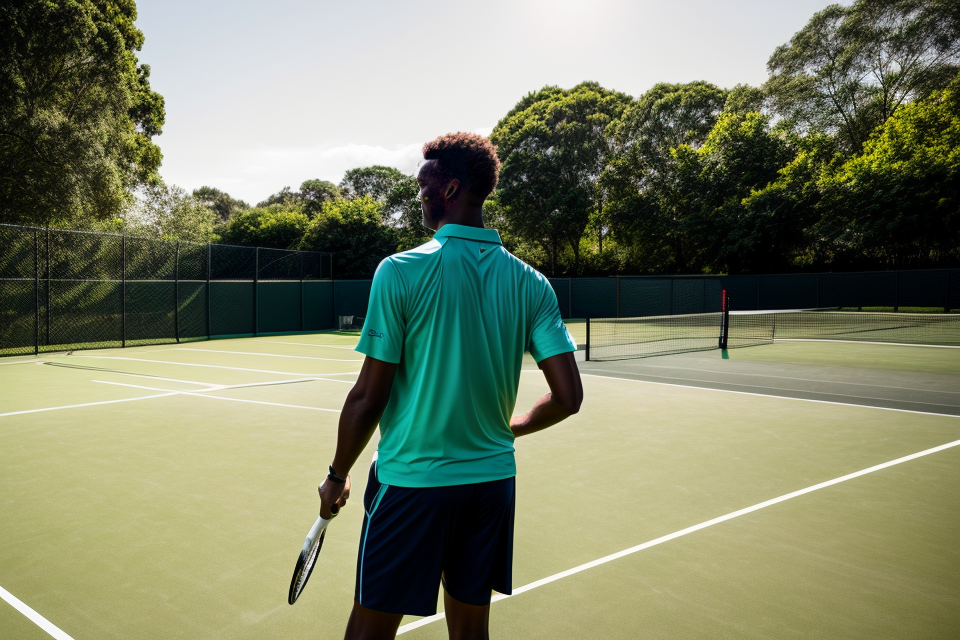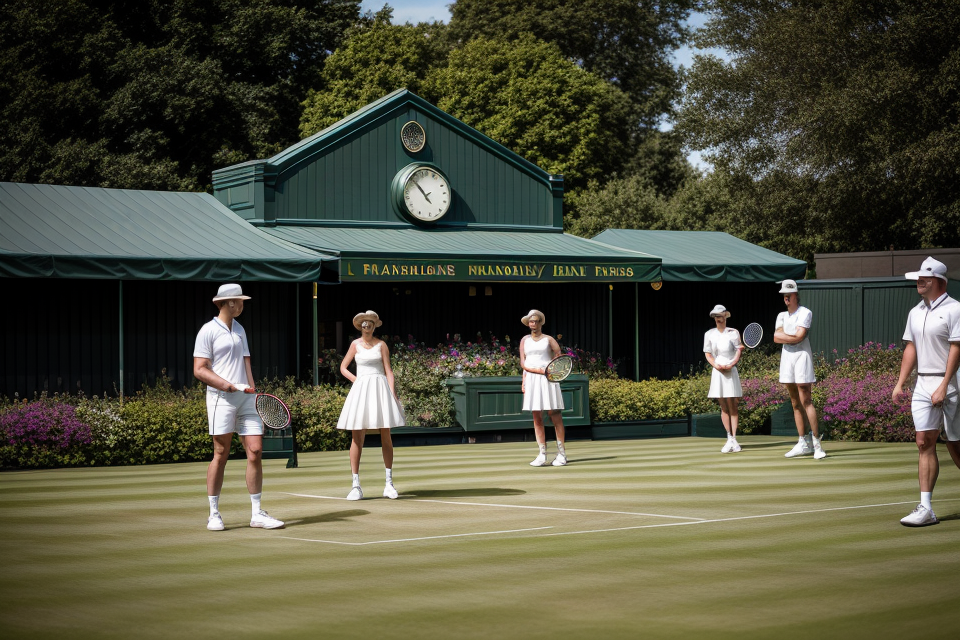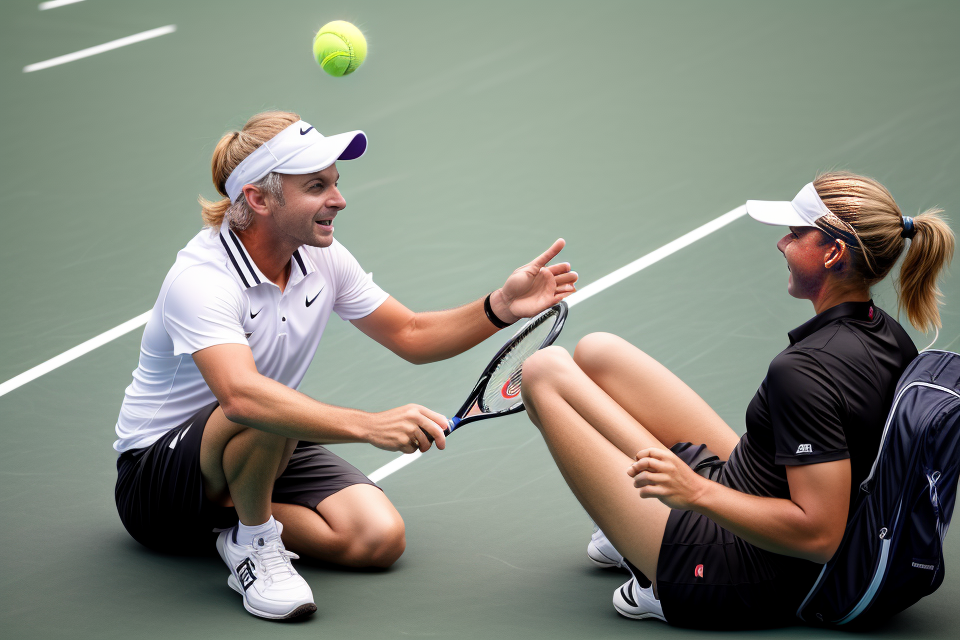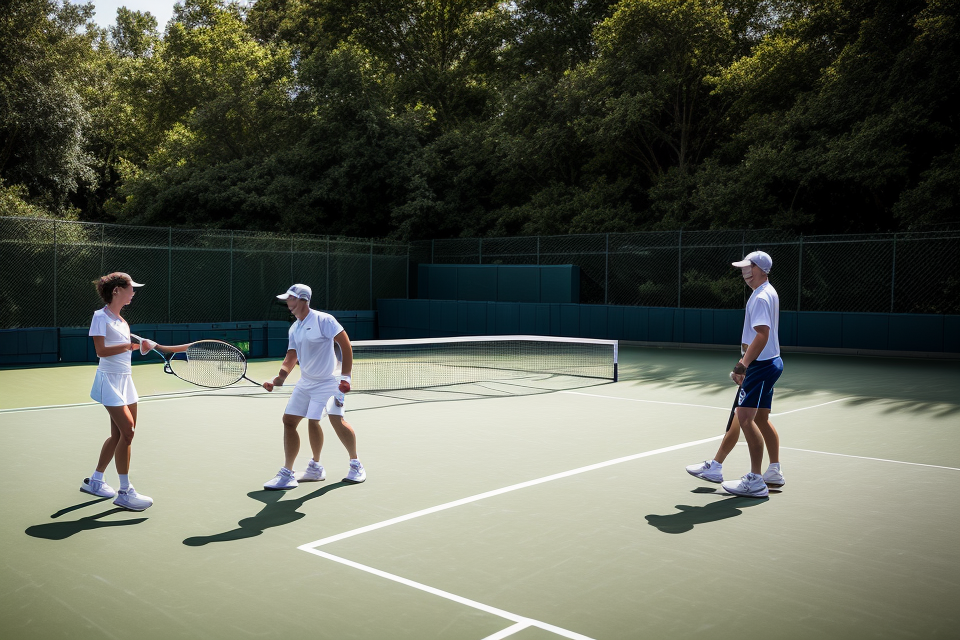Are you looking to take your tennis game to the next level? Do you want to improve your skills quickly and efficiently? Look no further! In this article, we will provide you with tips and tricks on how to enhance your tennis game and become a better player in no time. From mastering your serves to improving your footwork, we’ve got you covered. So, get ready to step up your game and dominate the court with these expert-approved techniques. Let’s get started!
To improve your tennis skills quickly, focus on the following key areas: practice your fundamental techniques, such as grip, stance, and footwork; hit a variety of shots, including forehand, backhand, and volleys; and develop your endurance and stamina through cardio exercises. Additionally, work on your mental game, such as focus, concentration, and positive self-talk. Lastly, play as many matches as possible, as this will give you the opportunity to apply your skills in a real-life setting and identify areas that need improvement.
Setting Goals for Tennis Improvement
Identifying Areas for Improvement
One of the key steps in improving your tennis skills quickly is identifying the areas where you need to improve. This will help you focus your efforts and make the most of your practice time. Here are some ways to identify areas for improvement:
- Analyzing your current tennis skills
Take an honest assessment of your current skills and identify the areas where you are struggling. This could include things like your serve, volley, backhand, or footwork. Be specific and don’t be afraid to identify areas that you know are weaknesses.
- Seeking feedback from a coach or a training partner
Another way to identify areas for improvement is to seek feedback from a coach or a training partner. A coach can help you identify areas where you need to improve and provide you with specific drills and exercises to help you improve. A training partner can also provide feedback on your game and help you identify areas where you need to improve.
It’s important to remember that improvement is a gradual process and it’s important to set realistic goals for yourself. Be patient and persistent, and remember that progress takes time. By identifying areas for improvement and setting goals for yourself, you’ll be well on your way to improving your tennis skills quickly.
Setting SMART Goals
Setting SMART goals is a popular method for creating effective and achievable goals. The acronym SMART stands for Specific, Measurable, Achievable, Relevant, and Time-bound. By following this framework, you can create goals that are clear, attainable, and actionable.
- Specific: A specific goal is clear and well-defined. It is not vague or ambiguous. It is essential to be as specific as possible when setting goals, as this will help you to focus on what you need to do to achieve them. For example, instead of setting a goal to “improve your tennis skills,” you should set a specific goal, such as “to increase your serve speed by 10% in the next three months.”
- Measurable: A measurable goal is one that can be quantified. It is essential to have a way to measure progress and success. Measurable goals can be tracked and measured, allowing you to see your progress and make adjustments if necessary. For example, you can measure your progress by tracking your serve speed or the number of aces you hit in a match.
- Achievable: An achievable goal is one that is realistic and attainable. It is essential to set goals that are challenging but achievable. Achievable goals can be motivating and give you a sense of accomplishment when you achieve them. It is crucial to consider your current skill level and abilities when setting achievable goals.
- Relevant: A relevant goal is one that is connected to your overall tennis improvement plan. It is essential to ensure that your goals are aligned with your long-term objectives. Relevant goals help you to stay focused and motivated, knowing that your efforts are contributing to your overall success.
- Time-bound: A time-bound goal is one that has a deadline. It is essential to set a specific time frame for achieving your goals. Time-bound goals create a sense of urgency and help you to stay focused and motivated. For example, you can set a goal to increase your serve speed by 10% in the next three months.
By setting SMART goals, you can create a clear and actionable plan for improving your tennis skills. Remember to review your goals regularly and make adjustments as necessary. With a clear plan and focused effort, you can improve your tennis skills quickly.
Developing a Tennis Improvement Plan
Creating a Training Schedule
Balancing on-court practice with off-court conditioning
To improve your tennis skills quickly, it is essential to strike a balance between on-court practice and off-court conditioning. While on-court practice helps you develop your technical skills and strategy, off-court conditioning helps you build the physical strength and endurance necessary to perform at your best during matches.
Some effective off-court conditioning exercises for tennis players include cardio workouts such as running, cycling, or swimming, as well as strength training exercises such as weightlifting, resistance bands, or bodyweight exercises. It is recommended to aim for at least 3-4 days of off-court conditioning per week, in addition to regular on-court practice.
Incorporating strength and conditioning exercises
In addition to off-court conditioning, incorporating strength and conditioning exercises into your training schedule can help you improve your tennis skills quickly. These exercises can target specific muscle groups used in tennis, such as the legs, core, and upper body, and can help you build the power, speed, and endurance needed to perform at your best.
Some effective strength and conditioning exercises for tennis players include squats, lunges, planks, push-ups, and resistance band exercises. It is recommended to aim for at least 2-3 days of strength and conditioning exercises per week, in addition to regular on-court practice and off-court conditioning.
Overall, creating a balanced training schedule that includes a combination of on-court practice, off-court conditioning, and strength and conditioning exercises can help you improve your tennis skills quickly and effectively.
Seeking Professional Guidance
Working with a Tennis Coach or Trainer
A professional tennis coach or trainer can provide personalized guidance and support to help you improve your tennis skills quickly. They can assess your current level of ability, identify areas for improvement, and create a customized training program tailored to your individual needs and goals.
Here are some tips for working with a tennis coach or trainer:
- Look for a coach or trainer who has experience working with players at your skill level.
- Ask for references and speak with other players who have worked with the coach or trainer to get a sense of their coaching style and effectiveness.
- Be open and honest with your coach or trainer about your goals and challenges, and ask for feedback and advice on how to improve.
Joining a Tennis Academy or Program
Joining a tennis academy or program can provide a structured and supportive environment for improving your tennis skills. These programs often offer group and individual lessons, as well as match play and tournament opportunities.
Here are some things to consider when choosing a tennis academy or program:
- Look for a program that aligns with your goals and level of ability.
- Consider the location, cost, and scheduling of the program.
- Ask about the experience and qualifications of the coaches and instructors.
By seeking professional guidance and support, you can quickly improve your tennis skills and achieve your goals on the court.
Mastering the Fundamentals
The Importance of the Basic Techniques
- The Grip, Stance, and Footwork
- The correct grip on the tennis racket is essential for controlling the ball and producing power in your shots.
- A proper stance provides balance and stability, allowing you to make smooth movements and transfer your weight efficiently.
- Footwork is the foundation of your game, enabling you to reach the ball and move effectively around the court.
- The Backhand and Forehand Shots
- The backhand shot is executed with the opposite hand and arm, using a continuous swing that connects the grip end of the racket to the hitting hand.
- The forehand shot is performed with the dominant hand and arm, following a similar swing pattern but starting with the racket in front of the body.
- Both shots require a well-timed release of the racket head, generating speed and spin to control the ball’s direction and velocity.
It is crucial to master these basic techniques, as they form the building blocks of your tennis game. Without a solid foundation in these fundamentals, you will struggle to improve your overall performance on the court. By dedicating time to practice and refine your grip, stance, footwork, backhand, and forehand shots, you will set yourself up for success and be able to develop your skills more quickly.
Drilling and Practice
Drilling and practice are essential components of improving one’s tennis skills quickly. Repetition and muscle memory play a crucial role in developing proper technique and building confidence on the court. To make the most of your practice time, it’s important to focus on technique over power.
Here are some tips for effective drilling and practice:
- Start with the basics: Before moving on to more advanced techniques, make sure you have a solid foundation in the basics. This includes proper grip, stance, and footwork.
- Practice regularly: Consistency is key when it comes to improving your tennis skills. Set aside time each day or week to practice, even if it’s just for a short period.
- Focus on one aspect at a time: Instead of trying to improve everything at once, choose one aspect of your game to work on and practice it until you feel comfortable. This could be your serve, volley, or backhand.
- Use drills to reinforce technique: Drills are a great way to practice specific aspects of your game and reinforce proper technique. For example, you could practice your backhand by hitting against a wall or using a feeding drill with a partner.
- Get feedback: Feedback from a coach or more experienced player can help you identify areas where you need to improve and give you specific tips for making those improvements.
- Practice under match conditions: The more you can simulate match conditions during practice, the better prepared you’ll be for actual matches. This includes practicing under pressure, serving and returning, and playing points.
By focusing on technique and practicing regularly, you’ll be well on your way to improving your tennis skills quickly.
Playing Smart Tennis
- Understanding the rules and strategies of the game
- Learning to play to your strengths and minimize weaknesses
Understanding the Rules and Strategies of the Game
To play smart tennis, it is essential to have a solid understanding of the rules and strategies of the game. This includes knowledge of the scoring system, the different types of serves, and the various techniques used in hitting the ball. By familiarizing yourself with these fundamentals, you will be better equipped to make informed decisions on the court and adjust your strategy as needed.
Learning to Play to Your Strengths and Minimize Weaknesses
In addition to understanding the rules and strategies of the game, it is crucial to learn how to play to your strengths and minimize your weaknesses. This means identifying the areas of your game that you excel in and focusing on improving those skills, while also working to improve your weaker areas.
One effective way to do this is by incorporating targeted practice drills into your training routine. For example, if you have a strong forehand shot but struggle with your backhand, you can focus on practicing your backhand to improve that area of your game.
Another important aspect of playing smart tennis is learning to conserve energy and avoid making unnecessary movements on the court. This means being strategic about when to move forward to hit the ball and when to stay back and defend. By conserving energy and making efficient movements, you will be able to maintain a higher level of intensity throughout the match and improve your overall performance.
Mental Game and Tennis Improvement
Building Confidence on the Court
- Visualization and positive self-talk
Visualization is a powerful tool for building confidence on the tennis court. It involves mentally rehearsing your performance, visualizing yourself making successful shots and handling different game situations. This helps to build confidence by reinforcing positive images in your mind and creating a sense of familiarity with successful outcomes.
Positive self-talk is another important aspect of building confidence. It involves replacing negative thoughts with positive ones, and using affirmations to boost your confidence and motivation. For example, instead of telling yourself “I’m not good enough,” you could say “I’m a skilled and confident player.” This can help to shift your mindset and build a sense of belief in your abilities.
- Managing stress and anxiety
Stress and anxiety can be major obstacles to building confidence on the tennis court. It’s important to find ways to manage these emotions so that they don’t interfere with your performance. This might involve relaxation techniques such as deep breathing, visualization exercises, or mindfulness practices. It could also involve developing a pre-match routine that helps you to feel calm and focused before you step onto the court.
Additionally, it’s important to remember that everyone experiences stress and anxiety to some degree, and it’s normal to feel nervous before a match. Acknowledging these feelings and reminding yourself that they are a normal part of the sport can help to reduce their impact on your performance.
Learning from Mistakes and Failures
In order to improve your tennis skills quickly, it is important to learn from your mistakes and failures. By embracing challenges and learning from your failures, you can develop resilience and perseverance, which are essential qualities for success in any sport.
Embracing challenges and learning from failures
Embracing challenges and learning from failures is crucial for improving your tennis skills. By facing challenges head-on and learning from your mistakes, you can become a better player.
One way to embrace challenges is to compete against opponents who are better than you. By playing against stronger players, you can learn from their techniques and strategies, and improve your own game. Additionally, competing against better players can help you develop mental toughness and resilience, which are essential qualities for success in tennis.
Another way to learn from failures is to analyze your mistakes and identify areas for improvement. By watching videos of your matches or working with a coach, you can identify areas where you need to improve, such as your footwork, stroke technique, or mental game. Once you have identified these areas, you can work on them specifically to improve your overall game.
Developing resilience and perseverance
Developing resilience and perseverance is key to improving your tennis skills quickly. Resilience is the ability to bounce back from setbacks and adversity, while perseverance is the ability to keep working towards a goal despite obstacles and challenges.
To develop resilience and perseverance, it is important to have a positive mindset and to stay focused on your goals. This means adopting a growth mindset, which is the belief that you can improve and develop through hard work and dedication. By believing in yourself and your ability to improve, you can stay motivated and committed to your goals, even in the face of challenges and setbacks.
Additionally, it is important to stay committed to your training and practice regimen, even when you encounter obstacles or setbacks. By continuing to work hard and stay focused on your goals, you can develop the resilience and perseverance necessary to improve your tennis skills quickly.
Overall, learning from mistakes and failures is a crucial aspect of improving your tennis skills quickly. By embracing challenges, analyzing your mistakes, and developing resilience and perseverance, you can become a better player and achieve your goals on the tennis court.
Nutrition and Recovery for Tennis Improvement
Fueling Your Body for Optimal Performance
As a tennis player, it is essential to pay attention to your body’s fuel and energy requirements to perform at your best. The right fuel and adequate rest can significantly impact your on-court performance. Here are some key aspects to consider when fueling your body for optimal performance:
Proper Hydration and Nutrition
Staying hydrated is crucial during tennis matches, as it helps maintain your energy levels and supports physical performance. Drinking water or sports drinks containing electrolytes can help replenish lost fluids and maintain the right balance of electrolytes in your body.
In addition to hydration, it is important to consume a balanced diet rich in carbohydrates, proteins, and healthy fats. Carbohydrates are an essential source of energy for tennis players, as they help maintain endurance and stamina during matches. Consuming lean protein sources like chicken, fish, and beans can help build and repair muscles after intense training sessions. Healthy fats, such as those found in avocados, nuts, and seeds, are also essential for overall health and can support energy levels.
Adequate Rest and Recovery Time
Rest and recovery are crucial for optimizing your tennis performance. Tennis matches can be physically demanding, and it is essential to allow your body time to recover between matches and training sessions. This includes getting enough sleep, reducing stress, and allowing your muscles to recover through proper stretching and rest.
Additionally, incorporating rest days into your training schedule can help prevent overtraining and injury. It is also important to listen to your body and adjust your training schedule if you experience any pain or discomfort. By prioritizing rest and recovery, you can ensure that your body is adequately prepared for the demands of tennis matches and training sessions.
Incorporating Rest and Recovery into Your Tennis Improvement Plan
Rest and recovery are essential components of any effective tennis improvement plan. Without giving your body sufficient time to rest and recover between practices and matches, you increase your risk of injury and reduce your ability to improve your skills. Here are some tips for incorporating rest and recovery into your tennis improvement plan:
- Giving your body time to recover between practices and matches
- It’s important to give your body time to recover between practices and matches to allow your muscles to repair and rebuild. This is especially true for high-intensity practices and matches, which can put a lot of stress on your body.
- Rest days or lighter training days can help your body recover and prevent overtraining.
- It’s also important to allow enough time between practices and matches to adequately prepare for the next one. This means allowing enough time for proper warm-up and cool-down, as well as for stretching and strengthening exercises.
- Prioritizing sleep and stress management
- Sleep is crucial for recovery and performance. It’s important to get enough sleep each night to allow your body to repair and rebuild.
- Stress can also have a negative impact on your body’s ability to recover. It’s important to manage stress through techniques such as meditation, deep breathing, or exercise.
- Prioritizing sleep and stress management can help you improve your overall well-being and reduce your risk of injury.
By incorporating rest and recovery into your tennis improvement plan, you can improve your body’s ability to repair and rebuild, reduce your risk of injury, and improve your overall well-being.
FAQs
1. What are the most important aspects to focus on in order to improve my tennis skills quickly?
The most important aspects to focus on in order to improve your tennis skills quickly are practice, consistency, and proper technique. Practice is crucial in order to develop your skills and build muscle memory. Consistency is important in order to see progress and maintain your improvements. Proper technique is essential in order to prevent injury and ensure that you are developing good habits that will stay with you throughout your tennis career.
2. How often should I practice in order to see significant improvement in my tennis skills?
In order to see significant improvement in your tennis skills, it is recommended to practice at least three to four times a week. However, it is important to also give your body time to rest and recover in order to prevent injury and ensure that you are able to give your best performance during each practice session.
3. What are some drills I can do to improve my tennis skills quickly?
There are many drills that you can do to improve your tennis skills quickly. Some effective drills include hitting against a wall or a practice partner, practicing your serves, and working on your footwork and agility. It is also important to incorporate drills that focus on specific aspects of your game, such as your backhand or volley, in order to become a well-rounded player.
4. How can I improve my physical fitness for tennis?
Improving your physical fitness for tennis involves a combination of cardiovascular exercise, strength training, and flexibility exercises. Cardiovascular exercise, such as running or cycling, will help improve your endurance on the court. Strength training will help build muscle and increase your power on the court. Flexibility exercises, such as stretching or yoga, will help improve your range of motion and prevent injury.
5. What equipment do I need to improve my tennis skills?
In order to improve your tennis skills, you will need a tennis racquet, tennis balls, and appropriate tennis shoes. It is also recommended to have access to a tennis court in order to practice your skills. If you are unable to access a court, you can still practice your serve and work on your footwork by hitting against a wall or using a practice net.



